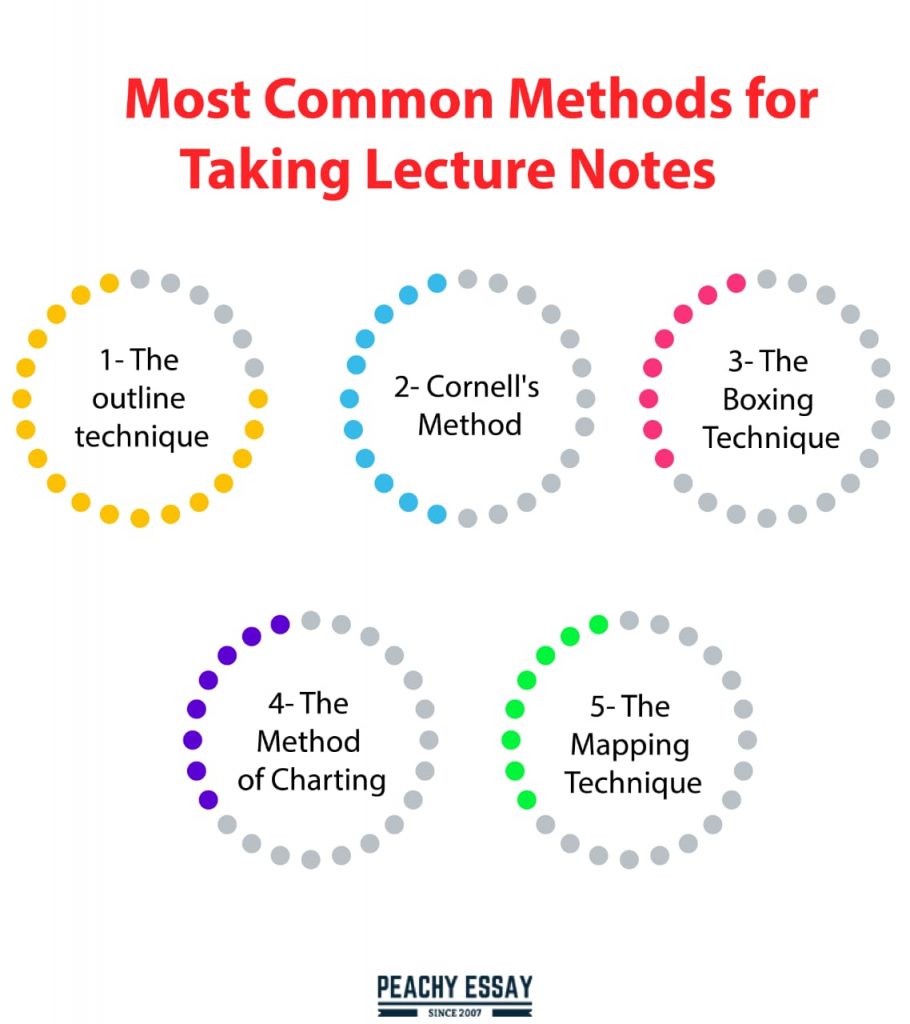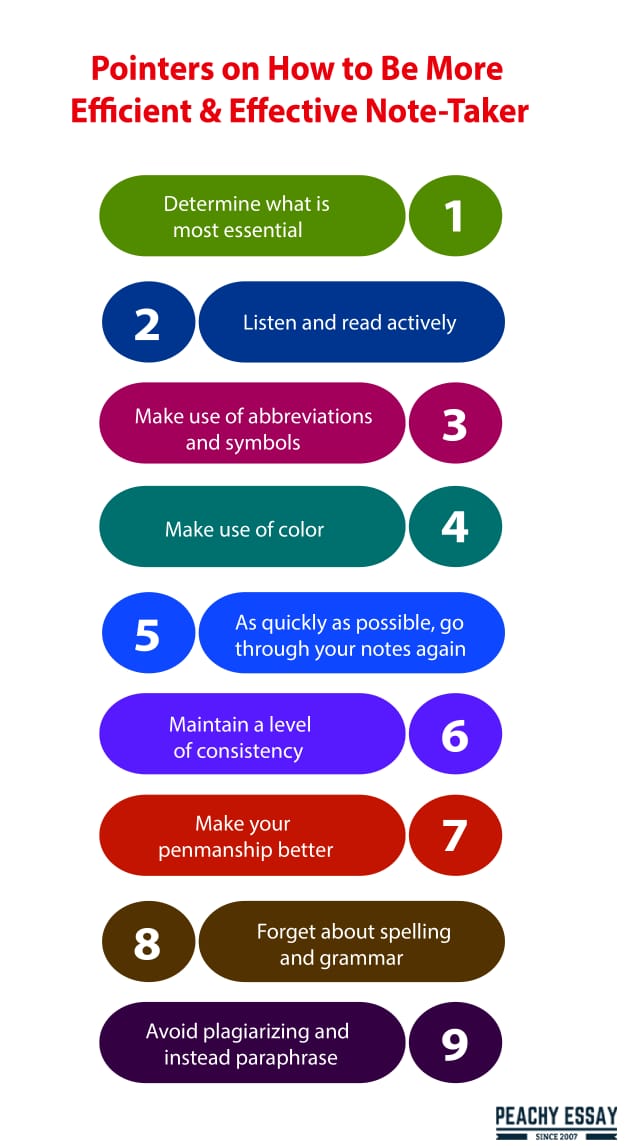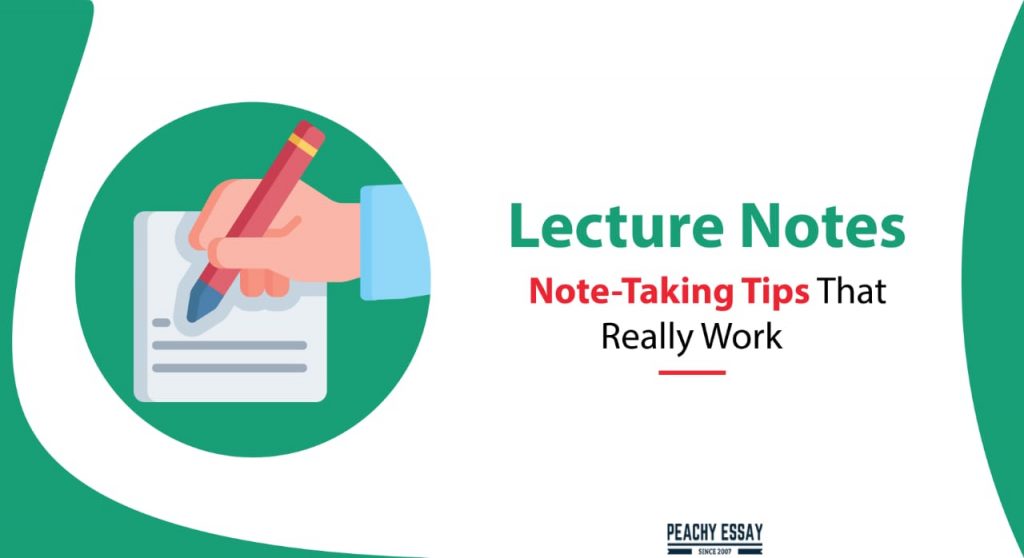With countless lectures, readings, essays, reports, and presentations, being a graduate student is a lot of work. As a result, you’ll feel compelled to collect as much information as you can from the onslaught of data.
Here are some helpful hints for jotting down key ideas during lectures.
Don’t write down every word
A lecture is not a dictation exercise in which you must write down everything spoken by the lecturer. In the lectures, keep an eye out for important ideas, arguments, and themes.
Pay close attention
It’s all too easy to become lost in thought during a presentation and overlook an essential topic. To avoid dozing off in class, try to get enough rest before lectures. Some people drink coffee before lectures to stay awake, while others chew gum. Pay close attention to any examples provided by the lecturer to illustrate a topic. The example may sometimes assist us in remembering the point in the future.
Capitalize, underline, and highlight
Certain words or phrases are often emphasized or drawn attention to by lecturers. To emphasize how essential these words are, underline or highlight them in your notebook. It’s also a good idea to start utilizing these phrases in your group conversations to familiarize yourself with them.
Make use of shorthand (Abbreviations)
Some words must be put in short but comprehensible forms to catch up. So, choose a shorthand code that you’re comfortable with and practice it. Words like ‘2’ instead of ‘to,’ ‘too,’ and ‘two,’ or ‘da’ for ‘the,’ ‘w/’ for ‘with,’ btw for ‘between,’ and so on.
Remove all potential sources of distraction
To prevent getting distracted messages on WhatsApp or Facebook, it may be a good idea to switch off your Wifi during lectures. Remember to turn your phone to quiet mode and avoid using headphones or earpieces!
Relax and unwind
Make sure you arrive on time for your lectures and select a comfortable seat. When their preferred seat in the lecture hall is already occupied, students are frequently discouraged. Choose a location that makes you feel at ease and like you’re a part of the presentation. For me, the second or third row is ideal. I have a hard time concentrating in the backseats. They remind me of the rowdy backbenchers in high school who laughed and planned pranks on instructors and classmates!
When you’re unsure, ask questions
Don’t simply scribble stuff down that you don’t comprehend. When you’re unsure, ask for clarification. If you have any questions, you may always meet with the lecturer during breaks, after the lecture, or during Office Hours.
Share and compare notes with classmates
According to the common saying, two heads are better than one. Finding time to exchange notes with your students and using their notes to update yours and vice versa is a fantastic idea. They may have seen something crucial that you didn’t.
Laptop vs. Notepad
There has been much discussion over which of these two is the most efficient for taking notes during lectures. Some claim that notepads are antiquated, while others maintain that computers are inconvenient. It depends on the person, in my opinion. I began with notepads and then progressed to my laptop. It is up to you to decide which is more effective. In certain courses, though, I still utilize my notebook. The important thing is to do what works best for you.
Let your voice be heard
Not all lectures are one-sided. Lecturers will sometimes ask students questions or solicit responses. Don’t let yourself down. Discuss how the topic connects to what you’ve already heard or seen, as well as your own feelings about it. Seminars and courses also provide additional opportunities for personal thinking on the topic. They make it easier to conduct critical analysis and hash out issues raised during the presentation. You may also comment on the lecture and make your own case here. “A lecture is far more of a conversation than many of you probably realize,” George Wald correctly observes.
Different Ways to Take Lecture Notes
The many methods of taking lecture notes are listed below.
Using a computer or tablet to take lecture notes
Many individuals can type more quickly than they can write. This may make taking lecture notes on a laptop or tablet extremely attractive. Furthermore, note-taking tools such as Evernote or OneNote may assist you in organizing your lecture notes.
However, there are certain disadvantages to utilizing a machine. To begin with, you have the world of social media and the Internet at your fingertips, which may be a convenient source of distraction. Second, note-taking is typically very linear — you start at the top and work your way down the page. This isn’t a good option if you’re a visual-spatial learner or if you have trouble consolidating knowledge in a lengthy textual form. Furthermore, while typing, pupils tend to copy the lecturer’s words literally. They’ll frequently be more concerned with typing everything down than with really comprehending the subject.
If you wish to take lecture notes on a laptop or tablet, being prepared will offer you the greatest chance of success. To save even more time during lectures, learn how to write fast and develop or master a range of shortcuts and abbreviations. You may also need to construct lists or tables, so it is advantageous to understand how to do it fast.
Taking notes on paper during a speech
According to studies, taking notes by hand helps us remember more information. This is most likely because taking lecture notes with a pen takes longer than typing on a laptop, which means you can’t write verbatim and must concentrate more on what’s being discussed. Because your brain is more ‘engaged’ while writing lecture notes by hand, you’re more likely to transfer the material to long-term memory.
In any event, for certain disciplines – especially math and languages – where the content isn’t necessarily straight text, taking lecture notes by hand is the logical option.
Taking lecture notes using a pen and paper offers several advantages. However, if you want to take your lecture notes this way, you’ll need to learn new skills and methods.
Consider keeping a separate notepad for each lesson. This helps to keep things more orderly. You’ll also need a variety of colored pens or markers to ensure that all of the key points from the lecture are clearly reflected in your notes. Finally, you must be able to communicate effectively in writing. If all you see two weeks later is incomprehensible chicken scratch, your notes are useless!
When is it Appropriate to Take Lecture Notes?
When is the ideal moment to take notes during a lecture? The simple answer is that it happens very often. In fact, before, during, and after each lesson, you should take notes. This includes taking notes while completing any necessary preparation reading as well as while listening in class. After the presentation, you should check your lecture notes regularly. This may be done once a week first, then more often when examinations or essay tasks approach.
Taking notes before a lecture
Before each lecture, you must at least partially complete the prescribed readings. Your instructors will frequently advise you that this is an important part of studying the subject (or succeeding in lectures). Despite this, only a small percentage of students really follow this advice.
So, go ahead and read. Also, take notes while you’re doing it. There are three advantages here (at least). To begin, familiarizing yourself with the lecture content ahead of time will ensure that you are aware of the topics covered, allowing you to spend more time in the lecture concentrating on essential points. Second, reviewing the information at least twice will aid in its retention in your long-term memory (great for exams). Finally, you may make a list of any questions you have and ask them during or after the presentation.
Taking notes while listening to a lecture
It may be difficult to know what to jot down during a presentation. Essentially, you want to jot down the most crucial details. You may accomplish this by improving your listening skills. The key to taking excellent lecture notes is to stay away from your professor’s tangents and focus on the information that will be covered on a test or in an essay. Your lecturer will offer you hints as to what will be on the exam. This will be accomplished via the use of important words or signposts.
Taking notes after a lecture
It’s a waste of effort to take excellent lecture notes before and during your presentation to have them gather dust afterward. Spend some time following the lecture checking your notes, and clarifying any points that may have seemed a little hazy. It will just take a few minutes on the same day, plus 10-15 minutes a few days afterward.
Additionally, it would be best to combine the notes you took while reading with those you took during the lecture. Put them up against one other. Examine the many bits of data and attempt to make sense of what you’ve written. Organize them in a logical order for you. Some may refer to this as a master outline, but what you’re really doing is finding out the key points and organizing them in a logical order.
Popular Styles of Taking Lecture Notes
Here are some of the most common methods for taking lecture notes.

The outline technique
One of the finest and most common note-taking techniques for college students is the outline approach. It allows you to arrange your notes systematically, freeing up time for additional examination and editing. As the name implies, this technique requires you to organize your notes in the shape of an outline, with bullet points representing various themes and subtopics. Begin by writing the major subjects on the far left of the page, then use indents to add relevant subtopics in bullet points below.
Cornell’s method
It’s a one-of-a-kind note-taking technique that may be used in several circumstances. The page layout is what sets it apart from other approaches. The page is split into three or four parts, with one row at the top for the title and date (optional), another at the bottom, and two columns in the middle. The left column should have 30% of the width, while the right column should have 70%.
The boxing technique
All notes that are linked to each other are put together in a box using this technique. Each part of the notes has its own box, which reduces the amount of time spent reading and reviewing.
The method of charting
It’s an excellent technique for memorizing notes that include a lot of information in the form of facts and figures. Similar to a table or spreadsheet, the data will be arranged in many columns. Each column represents a distinct category, allowing the rows to be readily compared.
The mapping technique
The mapping technique works best when the lecture material is intensive. It helps you organize your notes by separating them into branches, allowing you to make connections between them. Begin by writing the primary theme at the top of the map. As you move down the page, keep breaking it into subtopics on the left and right.
Tricks to Taking Good Lecture Notes
Note-taking is a skill that we utilize in many aspects of our lives, including school, university, and the workplace. Many individuals, however, may recognize that they have not developed the skills required to get the most out of their note-taking, so here are 10 pointers on how to be a more efficient and effective note-taker. These may be used to take notes from a printed text or someone else’s spoken presentation.

Determine what is most essential
Listen for crucial words like ‘the most essential aspect is…,’ which acts as a big signpost alerting you that significant information is about to be presented and instructing you to get your pen ready to take notes. The author or instructor you’re working with will have their own distinct style and words that you should know, so get to know them.
Listen and read actively
It’s easy to become distracted and lose track of a lecture or written argument, so use some of these strategies to help you stay focused.
Make use of abbreviations and symbols
You won’t have time to write complete sentences while taking notes, and sometimes the material will be so dense and rapid that you won’t be able to type full words. Create your own collection of abbreviations and symbols. + or & for ‘and’; = for equals are two obvious examples. Other less common instances are w/ for ‘with’ and watch for ‘which.’ You’ll also be able to utilize subject-specific shorthands.
Make use of color
When taking notes, utilize various colored inks for additional clarity and enhance your active listening/reading skills. By switching to a different color, for example, you may demonstrate various topics and methods. This is particularly helpful if you plan on using your notes to write reports or study for tests later.
As quickly as possible, go through your notes again
Take your notes, but don’t just file them away and forget about them. The easiest way to make the most of your notes is to go back over them after a short period of time and perhaps rewrite them more clearly or in a different sequence, depending on how or why you want to utilize them. This will allow you to utilize the knowledge actively, and it will remain in your memory for a longer period of time.
Maintain a level of consistency
If you’re listening to an hour-long lecture, resist the urge to take copious notes for the first 10 minutes and then nothing for the remainder of the hour. Make sure you keep a steady pace and absorb information during the presentation. Don’t lose focus since a competent speaker will give excellent material throughout their lecture slot.
Make your penmanship better
Do not get so engrossed in taking notes that you lose sight of the fact that your handwriting has become illegible! Regardless of how weary your hand gets, remember to write or type properly and legibly throughout.
Forget about spelling and grammar (as long as you understand what you’re saying)
This is the one moment in your academic or professional life when a few spelling and grammatical errors will not be held against you. It is not essential to achieve excellence in these areas; instead, concentrate on collecting and recording data. And if it means slacking on your spelling and punctuation, then be it!
Avoid plagiarizing and instead paraphrase
This is particularly problematic when taking notes from printed materials. Do not copy information from another source without placing it in quote marks and indicating where it came from. If you do, you will forget that these are not your words and will use them as your own in a report or essay, committing plagiarism. If you don’t want to utilize someone else’s words, make sure you paraphrase them when taking notes (i.e., put a passage into your own words). There will be no misunderstanding afterward if you do this while taking notes.




